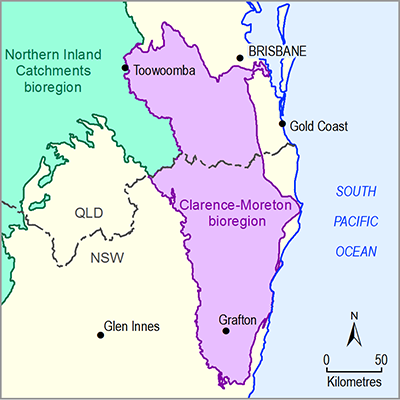There have been petroleum, conventional gas and unconventional gas exploration activities in different parts of the Clarence‑Moreton bioregion, including drilling of 105 CSG exploration wells and 49 petroleum exploration wells to date (Figure 9).
In conventional gas reservoirs, gas flow occurs naturally without prior depressurisation of the coal seams. Potential impacts of development of conventional gas resources are therefore not considered within the bioregional assessment, and these resources and potential developments are not discussed in detail in this report.
Petroleum tenures in Queensland that cover areas of CSG exploration and production are called ‘authority to prospect’ (ATP) and petroleum leases (PL). The ATP grants the holder the right for petroleum exploration, whereas the PL gives its holder the right to explore for, test for, and produce petroleum (DNRM, 2014).
In NSW, exploration activities are governed by the NSW Petroleum (Onshore) Act 1991. There are three main types of permits (or titles) issued under the Act. These are: petroleum exploration licences (PEL), petroleum assessment leases (PAL) and petroleum production leases (PPL). A PPL allows commercial petroleum extraction or production.
Current petroleum exploration permits (Queensland), current petroleum titles (NSW) and petroleum title applications (NSW) are shown in Figure 10.
CSG exclusion zones were introduced by the NSW Government in October 2013 for existing residential zones in all local government areas of the state. In July 2014, further amendments were made. The exclusion zones ban new coal seam gas activity inside those zones, and also within a 2 km buffer around all residential zones (NSW Government, 2014) (Figure 11).
The Commonwealth’s Environment Protection and Biodiversity Conservation Act 1999 (EPBC Act) was amended in June 2013 to ‘provide that water resources are a matter of national environmental significance, in relation to coal seam gas and large coal mining development’. Following this amendment, an ‘action which involves a CSG development or a large coal mining development now requires approval from the Australian Government Environment Minister (the Minister) if the action has, will have, or is likely to have a significant impact on a water resource’ (Department of the Environment, 2013).
On the 13th of November 2014, the NSW government has released its new NSW Gas Plan (NSW Trade and Investment, 2014b).
Source data: coal seam gas and petroleum exploration well location and depth of wells are sourced from (i) NSW Digital Imaging Geological Systems (NSW Trade & Investment, 2014a), © NSW Trade & Investment; (ii) Queensland Digital Exploration Reports (State of Queensland, 2014), © The State of Queensland 2014.
Source data: coal seam gas and petroleum exploration and appraisal well location and depth of wells are sourced from (i) NSW Digital Imaging Geological Systems (NSW Trade & Investment, 2014a), © NSW Trade & Investment; (ii) Queensland Digital Exploration Reports (State of Queensland, 2014), © The State of Queensland 2014.



